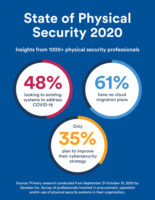State of the Industry: Change is Coming

During yesterday’s hour-long State of the Industry session, panelists provided insights on four pressing topics within the industry: “as a service,” consumerization, the emergence of security functions, and standards and interoperability.
Setting the stage for the first topic, Faddis used water, electricity and phone as examples of real-life “as a service” offerings – you pay a monthly fee for the ability to turn them on when you need them, off when you don’t.
Gary Wong of IMS Research told the audience that annual recurring monthly revenue (RMR) for video storage as a service (VSaaS) – which he calls the most mature as-a-service offering – is projected to surpass $1 billion by 2016. This growth (at a year-on-year rate of 28.6 percent) is directly tied to growth in popularity of networked cameras, which IMS says will surpass analog cameras in sales by year’s end and continue to grab greater market share at least until 2016.
Bill Taylor, Vice Chairman of the Security Industry Association (SIA) Board of Directors, said those projections are both exciting and scary, bringing both opportunities and challenges for those in the security industry.
“For those who haven’t made the migration [to networked cameras], you have to get on board with the transition as quickly as possible,” he said.
It’s no secret that increasingly tech-savvy consumers are impacting the security industry, especially in the area of mobility, Faddis said.
“The ability to gather data, social networks, tweeting – these cause a lot of problems in the security industry,” he said. “How do we allow for that convenience and protect that, and how are these devices going to work and still protect IT?”
Compounding the issue, said HID Global’s Jason Bohrer, is the fact that people expect to be able to use those devices both at home and at work.
“They want the flexibility to use them in both places and take advantage of all the aspects of mobility while also getting the benefits of security,” he said.
The problem isn’t going to get any better. Dropping another interesting statistic on the audience, Wong said IMS projects that by 2016, the number of smart devices shipped will close in on 1.4 billion.
“The IT department is understandably nervous about 1.4 billion devices coming into the workplace that they can’t control. But it hasn’t stopped, it’s not going to stop, and they’re not going to be able to control it,” Taylor said.
The key, said Francis D’Addario of the Security Executive Council, is to find a way to provide safe passage for these devices onto the network.
“There’s tremendous upside in the stickiness of allowing devices into the picture, but you also have to be tracking any anomalies,” D’Addario said.
Emerging security functions, the day’s third topic, centered around the notion of “bucketizing” various security functions in the cloud and delivering them on an as-needed basis.
The “bucket” that’s seen the most traction, Wong said, is video analytics, which is increasingly being used as a business intelligence tool, rather than a security tool. For retailers, the ability to track customer flow and other business-related activities helps provide a strong ROI angle for their businesses.
Too often, Taylor said, rather than use analytics to expand camera functions, the security industry focuses solely on the security aspect of video, potentially leaving revenue on the table.
“You have to introduce new revenue streams – not only security and threat types, but turn the camera into data collection units for more than just security,” he said. “It’s not just ‘bad guy’ applications we should be interested in, but also ‘good guy’ applications that help businesses.”
Understanding how these individual security functions (i.e. clouds) interrelate and work together is just as important as delivering services on demand, Bohrer said.
“Looking forward, we’re going to see a natural cohesion of clouds,” he said.
As anyone in the industry knows, standards and interoperability are major issues. But they’re two separate things. The ability for equipment from different manufacturers to work together seamlessly is critical for installations.
“Standards are a double-edged sword. Without compatibility between equipment, it’s very difficult to install systems across multiple locations,” Taylor said. “They also don’t allow you to take advantage of the outstanding features built into cameras, which aren’t covered by standards.”
In terms of standards and interoperability, the security industry should aspire to what the computer industry has accomplished, Taylor said.
“Nobody’s done it like the IT world. The 802.11 standard is ubiquitous,” he said. “That’s where the standards-setting bodies of the industry associations can help. I’d urge everyone to encourage them to work on interoperability and interconnectivity standards.”
In the end, D’Addario said, everything comes down to risk.
“There are going to be breaches. Nothing’s changed, but the opportunity has changed,” D’Addario said. “Bottom line is to start with risk. You have to have the ability to look at end user risk, map it out and map out a migration pathway with the whole team.”
Looking for a reprint of this article?
From high-res PDFs to custom plaques, order your copy today!








